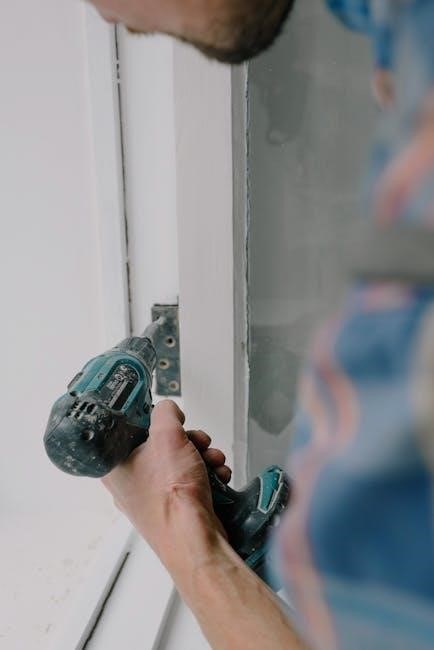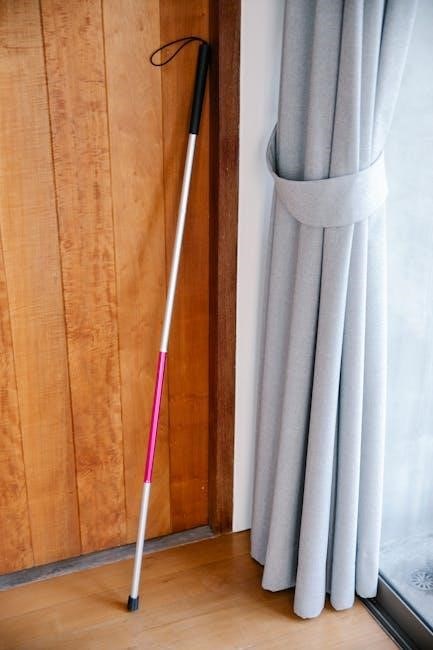Pocket door installation is a popular choice for modern homes due to its space-saving design and sleek appearance. This guide provides a comprehensive overview of the process, from preparation to final adjustments, ensuring a smooth and successful installation experience.
1.1 Overview of Pocket Door Systems
Pocket door systems are designed to save space and offer a sleek, modern aesthetic. These systems typically include a frame, rollers, and tracks that allow the door to slide into a wall cavity. The frame is usually pre-assembled, and the rollers attach to the door, enabling smooth movement. The tracks are mounted into the wall studs, ensuring stability. This setup is ideal for rooms where traditional swinging doors would occupy valuable space, making it a practical solution for both new constructions and renovations.

1.2 Benefits of Installing a Pocket Door
Installing a pocket door offers numerous advantages, including significant space savings and a sleek, modern aesthetic. Unlike traditional swinging doors, pocket doors slide into a wall cavity, making them ideal for tight spaces. They enhance functionality in areas like bathrooms, closets, and living rooms while maintaining a clean, minimalist look. Additionally, pocket doors can improve accessibility and are often easier to use, especially in busy households. This feature can also boost a home’s value and appeal.

Tools and Materials Required
Essential tools include a tape measure, level, drill, and stud finder. Materials needed are a pocket-door kit with a frame header, split steel studs, and door hangers. Having the right tools and materials ensures a smooth and professional installation process.
2.1 Essential Tools for Installation
Installing a pocket door requires specific tools for accuracy and efficiency. A tape measure ensures precise measurements, while a level guarantees proper alignment. A drill and stud finder are crucial for locating and securing wall studs. Additional tools include a saw for cutting studs, a wrench for tightening hardware, and a pencil for marking walls. Having these tools ready streamlines the process and helps achieve a professional finish. Safety gear, like safety glasses, is also recommended to protect during cutting and drilling.
2.2 Necessary Materials and Components
The essential materials for a pocket door include a pocket door frame kit, which typically contains a header assembly, split steel studs, and door hangers. Additional components like drywall, paint, and a door slab are also required. Ensure all parts are compatible with your wall type and door size. Some kits may include rollers and tracks, while others require separate purchases. Gathering all materials beforehand ensures a seamless installation process and prevents delays.

Pre-Installation Considerations
Measure the rough opening accurately and assess the wall structure. Plan the space to accommodate the door and ensure proper alignment for smooth operation.
3.1 Measuring the Rough Opening
Accurate measurement of the rough opening is crucial for a proper fit. Use a tape measure to determine the width and height, ensuring the space aligns with the door size. Check for obstructions and verify the opening is square. Measure twice to confirm accuracy, as incorrect measurements can lead to installation issues. This step ensures the pocket door system fits seamlessly, maintaining smooth operation and structural integrity.
3.2 Assessing Wall Structure and Space
Assessing the wall structure and available space is essential before installation. Determine if the wall is load-bearing or non-load-bearing and check for plumbing or electrical components. Ensure the wall studs are aligned properly and measure the clearance needed for the door to slide smoothly. Verify that the ceiling height and adjacent rooms allow for proper door movement. This step ensures the pocket door system fits seamlessly into the existing space without compromising functionality or safety.

Installing the Pocket Door Frame
Installing the pocket door frame involves assembling components, fitting them into the measured opening, and securing them to ensure proper alignment and structural integrity for smooth door movement.
4.1 Assembling the Frame Header
Assembling the frame header is the first step in installing the pocket door frame. Begin by measuring and aligning the tracks according to the manufacturer’s instructions. Attach the hinges to the door and the rollers to the frame, ensuring proper alignment. Secure the header to the wall studs using screws, making sure it is level and plumb. Double-check all connections for stability and adjust as needed before proceeding to the next step.
4.2 Cutting and Fitting Wooden Studs
Cutting and fitting wooden studs is crucial for a sturdy pocket door frame. Measure the rough opening to determine the required length of the studs. Use a saw to cut the studs precisely, ensuring they fit snugly into the wall cavity. Align the studs with the header and footer tracks, securing them firmly. Double-check the fit to avoid gaps, and make adjustments as needed. Properly fitted studs ensure the frame is stable and ready for hardware installation.

Hardware Installation
Hardware installation involves attaching door hangers, rollers, and tracks. Securely fasten these components to ensure smooth door operation and proper alignment, preventing future functionality issues.
5.1 Attaching Door Hangers and Rollers
Begin by aligning the door hangers with the track, ensuring proper spacing and level placement. Secure the hangers to the door frame using screws, then attach the rollers to the door. Make sure the rollers are evenly spaced and tightly fastened to prevent wobbling. Double-check the alignment to ensure smooth movement. Properly installed hangers and rollers are crucial for the door’s stability and functionality, preventing misalignment or operational issues over time.
5.2 Securing the Door to the Frame
After attaching the hangers and rollers, secure the door to the frame using the provided screws. Ensure the door is properly aligned with the track and frame for smooth operation. Check the door’s level and plumb to avoid uneven movement. Tighten all screws firmly but avoid overtightening, which could misalign the door. Double-check the fit to ensure the door glides effortlessly within the frame, providing a stable and functional installation.

Common Challenges and Solutions
Common challenges include misalignment, insufficient wall support, and improper hardware installation. Solutions involve precise measurements, reinforcing walls, and ensuring all components are securely fastened for smooth operation.
6.1 Addressing Alignment Issues
Alignment issues are common during pocket door installation, often caused by uneven framing or incorrect measurements. To resolve this, ensure the track is level and securely fastened. Adjust the door hangers and rollers to align properly with the track. Double-check all components for proper fit and make necessary adjustments. If the door sags, tighten the suspension bolts or shim the frame as needed. Proper alignment ensures smooth operation and prevents damage to the door or surrounding structure over time.
6.2 Ensuring Proper Wall Support
Proper wall support is crucial for the stability and functionality of a pocket door system. Ensure the wall structure can handle the door’s weight by installing a sturdy frame and securing it with reinforced brackets or steel studs. Check for any structural weaknesses and address them before proceeding. If the wall lacks sufficient support, consider adding a header or consulting a professional, especially for load-bearing walls. Proper wall support prevents sagging and ensures the door operates smoothly and safely over time.

Final Adjustments and Testing
After installation, test the door’s operation, ensuring smooth movement and proper alignment. Adjust rollers or tracks if needed for even sliding. Verify the door is level, closes fully, and all hardware is secure.
7.1 Fine-Tuning the Door’s Movement
Once installed, fine-tune the door’s movement by checking alignment and ensuring smooth operation. Lubricate rollers and adjust tension as needed. Verify the door glides evenly without binding. Test by sliding the door multiple times to ensure consistent movement. Make sure the door aligns properly with the frame and doesn’t catch on surrounding surfaces. Adjust the height if necessary to maintain levelness. This step ensures the door operates seamlessly and lasts longer.
7.2 Ensuring Smooth Operation
To ensure smooth operation, inspect the door’s track and surrounding area for obstructions. Verify proper alignment of the door with the frame and ensure the rollers are securely attached. Check the door’s height and adjust if necessary to maintain even movement; Test the door by sliding it multiple times, ensuring it glides effortlessly without catching or binding. Lubricate moving parts if needed and tighten any loose screws. Proper adjustment guarantees long-lasting, trouble-free performance.

Post-Installation Tips
After installation, add finishing touches like painting or adding door handles. Regularly lubricate rollers and clean the track to prevent wear. Check alignment and tighten hardware as needed for smooth, long-term functionality.
8.1 Adding Finishing Touches
After installing the pocket door, focus on adding finishing touches for a polished look. Install door handles or hardware, ensuring they align with the surrounding design. Paint or stain the door and frame to match the room’s aesthetic. Add trim or molding to conceal gaps and enhance the appearance. Ensure all visible components are securely fastened and aligned properly. These final details will complete the installation, providing a seamless and professional result.
8.2 Maintenance and Care

Regular maintenance ensures your pocket door operates smoothly. Clean the tracks and rollers periodically to remove dust and debris. Lubricate moving parts with silicone spray to prevent squeaking and wear. Check alignment and tighten hardware if necessary. Inspect for signs of wear, such as damaged rollers or dented tracks, and replace components as needed. Use a soft cloth to wipe down the door and frame, avoiding harsh chemicals that might damage finishes. Proper care extends the door’s lifespan and maintains its functionality.
